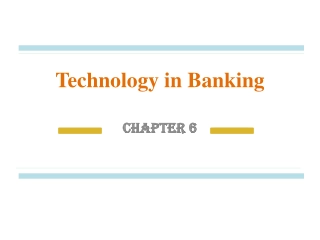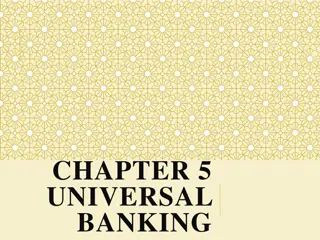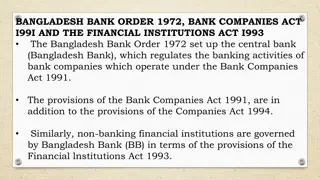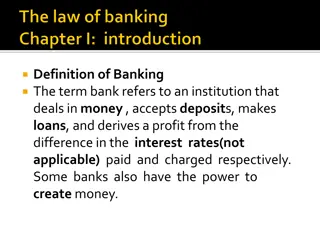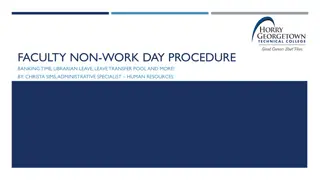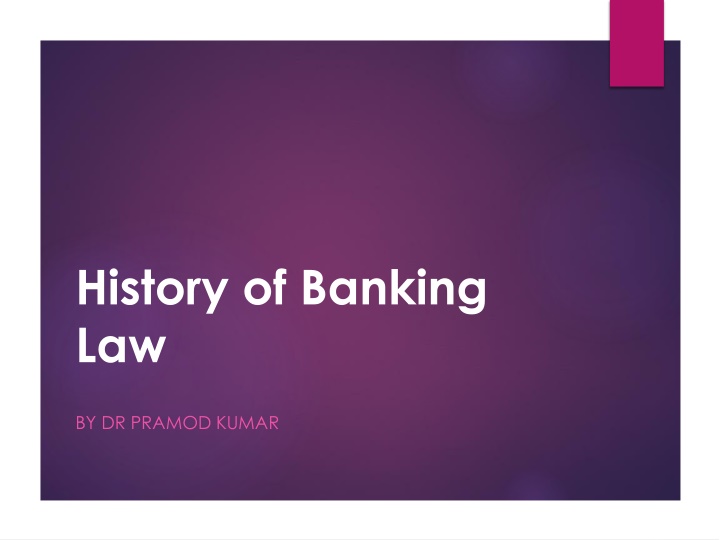
Evolution of Banking Law and Practices: A Historical Overview
Explore the rich history of banking law from ancient civilizations to modern times, tracing the evolution of banking practices globally. Discover the origins of banking in temples, the influence of Greek and Roman financiers, the emergence of banks in Venice and England, and the development of banking law in India. Learn about key milestones in the history of banking and how laws have shaped the financial landscape over centuries.
Download Presentation

Please find below an Image/Link to download the presentation.
The content on the website is provided AS IS for your information and personal use only. It may not be sold, licensed, or shared on other websites without obtaining consent from the author. If you encounter any issues during the download, it is possible that the publisher has removed the file from their server.
You are allowed to download the files provided on this website for personal or commercial use, subject to the condition that they are used lawfully. All files are the property of their respective owners.
The content on the website is provided AS IS for your information and personal use only. It may not be sold, licensed, or shared on other websites without obtaining consent from the author.
E N D
Presentation Transcript
History of Banking Law BY DR PRAMOD KUMAR
Safe in the temple: 18th century BC In early civilizations a temple is considered the safest place; It is a solid building, constantly attended, with a sacred character which itself may deter thieves. In Egypt and Mesopotamia gold is deposited in temples for safe-keeping. In Babylon at the time of Hammurabi, in the 18th century BC, there are records of loans made by the priests of the temple.
Greek and Roman financiers: from the 4th Century BC The Greek temples were used as depositories for people s surplus funds and these were the centres of money lending transactions. The priests of the temples acted as financial agents till they lost public confidence on account of people s disbelief in religion. Aristotle considered that the charging of interest was unnatural and consequently immoral. Some Mohammedans, in obedience to the commands contained in that behalf in their religious books, refuse to accept interest on money loans. Hebrews were of the opinion that there was no sin of interest, but only of usury.
Banking: 12th - 14th century In the middle of the 12the century, the first Bank was found at Venice in 1157. Later Bank were established at Barcelona (1157) and Genoa (1407) though they did not become banks. During the 13th century bankers from north Italy, collectively known as Lombards, gradually replace the Jews in their traditional role as money-lenders to the rich and powerful. The business skills of the Italians are enhanced by their invention of double-entry book-keeping. The origin of modern banking may be traced to the money dealers in Florence who received money on deposit, and were lenders of money in the 14thcentury.
Evolution of Banking in England In England, during the reign of Edward III, money changing function of bankers was taken up by a Royal Exchanger for the benefit of the crown and to exchange the various foreign coins. The development of business of banking mainly attributed to the London Goldsmiths during the reign of Queen Elizabeth I. In England, establishment of Bank in 1694. In 1826, an Act was passed in England which allowed the banks to started with unlimited liability, consisting of more than six partners with the right to issue note provided they had no office within the radius of 65 miles from London. The Act of 1833 permitted the formation of joint stock banks. It was full development of modern commercial banking in England.
Evolution of Banking Law in India The Law of Contract, the Law of Torts and other branches of Commercial applicable to banks as to others. and Civil law are Indian banking Law is based to a large extent upon English Banking Law. 1. The Negotiable Instruments Act, 1881- To regulate the law relating to bills of exchange and promissory note, To define and amend the law relating to promissory notes, bills of exchange negotiable or not. and cheques, whether It was extended to whole of India.
2. The Bankers Books Evidence Act, 1891: It is an important legislation which is made for Bankers only in India. It provides certain privileges to bankers as regard the mode of providing of entries in their books and the production thereof in Courts of Law.
3. The Banking Regulation Act, 1949 (Previously The Banking Companies Act, 1949) The Indian Companies Act, 1913 Was found inadequate. Banking Companies Act, 1949 To regulating banking and To provide for the nature of transactions which can be carried on by banks in India. The Banking Regulation Act, 1949 To regulate the functioning of banking companies.
The Reserve Bank of India Act, 1934 Section 3 of the RBI act provides for establishment of Reserve Bank of India for taking over the management of the currency from Central Government and of carrying on the business of banking in accordance with the provisions of this Act. Section 4 of the RBI Act defines the capital of RBI which is Rs. five crore. Section 7 of the RBI Act empowers the central government to issue directions in public interest from time to time to the bank in consultation with RBI Governor. This section superintendence and direction of the affairs and business of RBI to Central Board of Directors. also provides power of
Section 17- This section deals with the functioning of RBI. The RBI can accept deposits from the central and state governments without interest. It can purchase and discount bills of exchange from commercial banks. It can purchase foreign exchange from banks and sell it to them. It can provide loans to banks and state financial corporations. It can provide advances to the central government and state governments. It can buy or sell government securities. It can deal in derivative, repo and reverse repo.
Section 18- This section describes emergency loans to banks. Section 21- This section assigns RBI the duty of being banker to the central government and manage public debt. Section 22- This section grants power to RBI to issue the currency. Section 24-This section has provision that highest denomination note could be 10,000.
Section 28-This section empowers the RBI to form laws concerning the exchange of damaged and imperfect notes. Section 31- This section provides that in India RBI and central government only can issue and accept promissory notes that are due on request. Section scheduled bank need to hold an average daily balance with the RBI. 42(1)-This section provides that every

